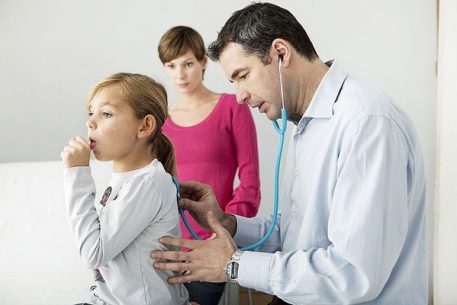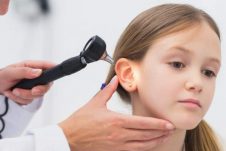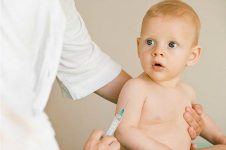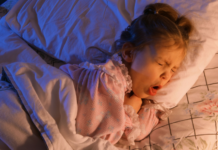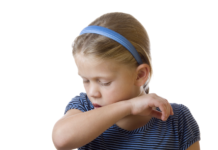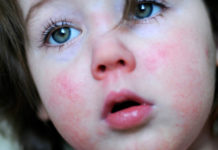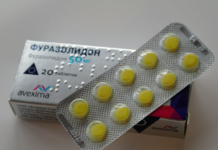This viral infection is more common in babies, sometimes affects adults. The predominant symptoms of measles in children depend on the stage of the disease - initial or primary. Among the complications, otitis media and pneumonia predominate.
Material Content:
What is measles and its causes
Measles occurs with intoxication and rashes. Thanks to vaccinations, cases of the disease in developed countries do not become epidemic. However, it is too early to consider measles defeated, as evidenced by outbreaks of infection in Western and Eastern Europe in 2017–2018.
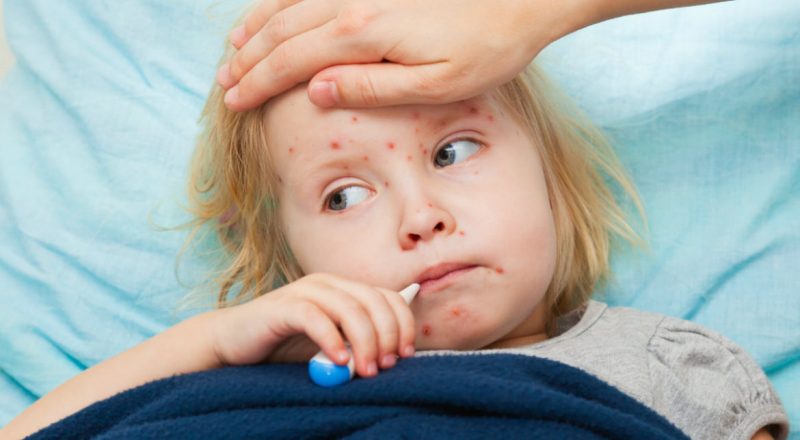
Measles-causing virus belongs to the genus morbilliviruses of the paramyxovirus family. Its contagiousness (infectiousness) reaches almost 100%. The causative agent is transmitted with droplets of sputum and saliva by coughing, sneezing, normal conversation. The infection is contagious for those who have not previously been exposed to the measles virus, are not protected by the vaccine (were not vaccinated).
More often children are ill. Most adults in the body have antibodies formed after childhood illness or after vaccination. This type of immunity lasts for life. If in the blood of the mother of the newborn there are appropriate antibodies, then the immunity to infection is transmitted to the child and the first 3-6 months of his life are preserved.
Measles in adults often acquires a complicated course, compared with children. The greatest risk of infection is for pregnant women.Contact with measles patients should be avoided as much as possible.
Incubation period
Morbilliviruses penetrate the mucous membrane of the respiratory tract, are carried with blood throughout the body. This condition - primary viremia - is not accompanied by symptoms. The pathogen is in the lymph nodes, where it multiplies, after which it again enters the bloodstream. With secondary viremia, the infection suppresses the functions of the immune system, causing painful changes in the state of the body.
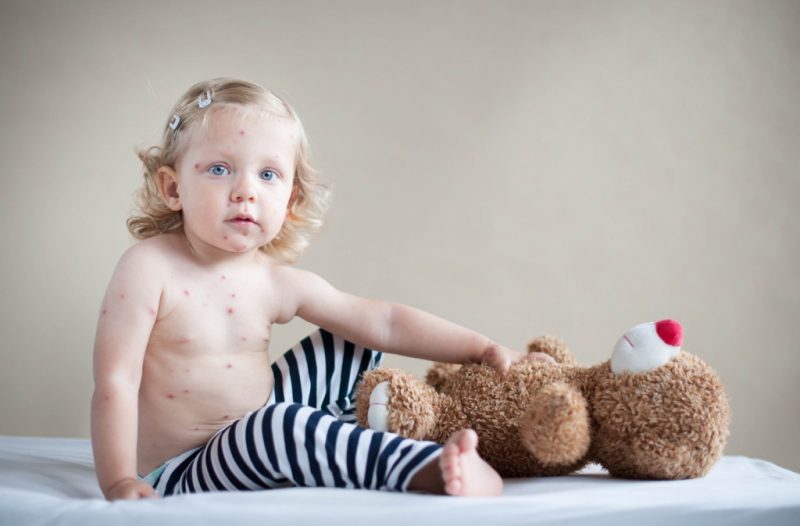
Skin rashes do not occur immediately after exposure to measles virus. The incubation period lasts from 8-10 to 14-17 days. By the end of this period of time, flu-like symptoms appear. The greatest risk of infection in healthy people exists at the initial stage of the disease in infected measles.
The first signs of a viral disease
In the first day after the incubation period, the patient develops flu-like symptoms. Suddenly stuffy nose, reddening throat, the temperature rises to 38–40 ° С. The child sneezes, his eyes watery, sensitivity to daylight increases. The patient feels slightly better in a darkened room.
Initial signs of measles in a child:
- hoarseness, throat irritation;
- swelling and redness of the eyelids;
- photosensitivity;
- sore throat;
- fever (40 ° C);
- headache;
- dry cough.
Fever - a consequence of the effects of pathogens and toxins on the body, as well as a protective mechanism against microbes.
The mucous membrane of the oral cavity in the sky is covered with pink dots. The next day, small white spots on a red base appear on the inner surface of the cheeks. Experts call these rashes spots Koplik-Belsky-Filatov. Foreign doctors use only the name “Koplik spots” in honor of the pediatrician G. Koplik, who described the symptom in 1896.
Symptoms of measles in children
At the beginning, the signs of the disease are difficult to distinguish from the common cold, SARS. The child chills, he speaks in the nose, coughs, complains of a “scratching” in the throat (if he can speak). Symptoms of general intoxication appear, appetite worsens. If the child is small, weakened, then febrile seizures may begin at ›38 ° C, when the temperature rises in a short period of time. The risk of this condition is higher in children aged 6 months to 6 years.
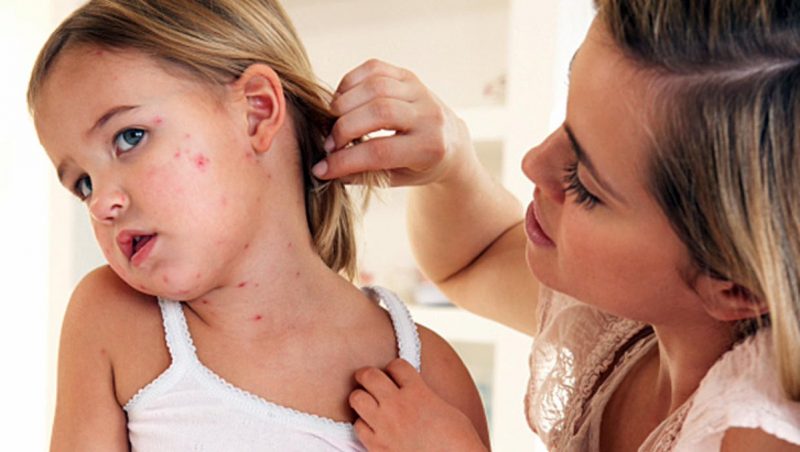
They call a doctor at home if a sick baby has a fever (38–39 ° C), febrile seizures develop, throat swelling occurs, breathing is difficult.
The first symptom of measles indicating the nature of the disease may be small Koplik spots. Before a typical skin rash appears, the fever decreases slightly. Small round spots and raspberry-colored nodules initially appear on the skin of the forehead and / or behind the auricles.
Bright red papules and spots have wavy edges, slightly elevated above the surrounding skin, prone to enlargement. Elements of the rash spread to the entire face, then go to the neck, descend on the body for 1-2 days. Against the background of general intoxication, in the midst of rashes, a second peak of fever begins. Viruses and toxins can cause an attack of febrile seizures in a young child. After a week, the baby's condition improves.
Stages of the course of the disease in a child
The first phase, which is characterized by the appearance of symptoms of a common cold, takes from 2 to 3 days. This stage of measles is called catarrhal or prodromal. White spots of Koplik on the mucous membrane of the cheeks, parents do not always notice, they may miss their education.
In the second stage, 12-14 days after infection, less than a week after the onset of the disease, a characteristic rash develops. The main elements are papules of small sizes on a red base. Rashes can spread to the entire body, up to the fingers on the palms and feet.
Bright red spots darken, then turn brown. Rashes disappear after 4 days in the same order. Peeling often remains in place of spots. Fever goes away after 3–7 days.
Measles treatment in children
Medical care for the patient is aimed at alleviating the condition of the body, timely detection and treatment of complications. There is no antiviral drug effective for treating measles in children. If the disease is severe, then isoprinosine is prescribed to patients older than 3 years. This antiviral, immunomodulatory agent helps suppress the activity of viruses. Pathogens do not multiply, less toxins are released into the blood.
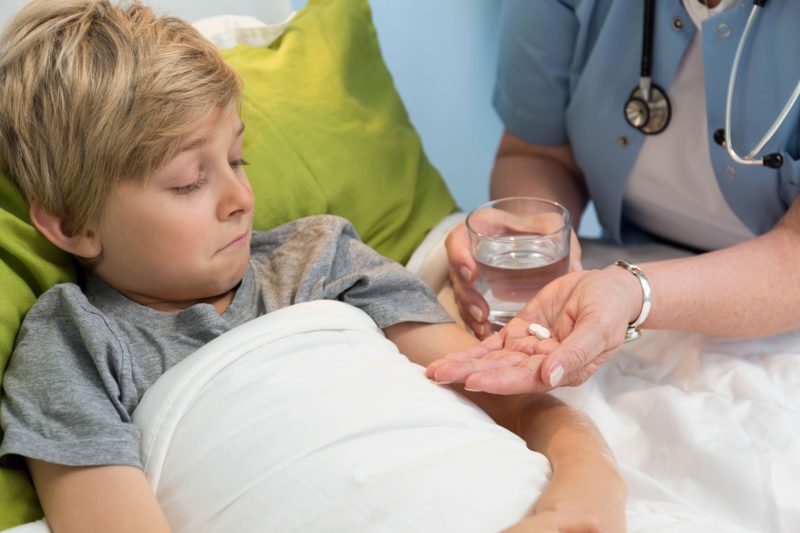
Temperature reduction
According to the WHO, paracetamol is the drug of choice at high temperatures in children. This antipyretic agent has an optimal ratio of the effect and toxicity to the body. The preferred dosage forms in pediatrics are oral syrup, granules for suspension, rectal suppositories.
With high temperature and vomiting in the baby, the appearance of fever and symptoms of febrile seizures at night, candles with paracetamol are used. The medicine in this form of release begins to act after 30 minutes, but the effect is not maintained throughout the night. The next candle can be entered only Syrup 3-4 hours after the first. Syrup with paracetamol acts just as quickly, retains an antipyretic effect for longer.
In case of fever in children older than 3 months, suspensions and tablets with ibuprofen are used. The medicine combines anti-inflammatory, antipyretic and analgesic effects. The risk of using ibuprofen is the development of hypothermia - a state of the body in which the temperature drops below normal levels (up to 35 ° C and below).
Analgin with diphenhydramine - a combination of solutions for intramuscular injection with moderate fever.
It is necessary to ensure an optimal drinking regimen during the illness in order to prevent dehydration of the body. The food should be light, contain vitamins A, C, group B. The child is put to bed in a cool, darkened room.
Antihistamines
Means for enhancing anti-inflammatory treatment and eliminating skin itching:
| Preparations | Active substance | Release form | At what age are used |
|---|---|---|---|
| Fenistil | Dimetinden | Drops | From 1 month |
| Zirtek | Cetirizine | Drops | From 6 months |
| Zodak | Cetirizine | Drops | From 12 months |
| Erispirus | Fenspiride | Syrup | From 2 years |
| Erespal | Fenspiride | Syrup | From 2 years |
Cough treatment
Inhalations will help maintain airway moisture. Syrups of marshmallow, ivy, plantain, Icelandic moss contribute to thinning thick sputum and facilitate dry cough. To give the child a softening tea with chamomile and rosehip, fruit drinks.
Antibiotics for the prevention of complications
The famous pediatrician E. Komarovsky does not get tired of repeating that viral infections are not treated with antibiotics. Doctors know this rule, but continue to prescribe antibacterial drugs for diseases that cause viruses. Antibiotics must be used with weakened immune defenses, high risk of bacterial superinfection, otitis media or pneumonia.
Possible complications and predictions
Viral infection weakens the immune system. Therefore, the body is less able to fight pathogenic microorganisms. A dangerous consequence of measles is encephalitis. In 3–9 days after the formation of a rash on the body, the child begins to feel dizzy, drowsiness intensifies. Other symptoms may appear - convulsions, paresis.
Complications of measles:
- bronchitis;
- pneumonia;
- otitis media;
- postinfectious encephalitis;
- inflammation of the cornea of the eye - keratitis (rarely).
Approximately 30% of affected children after encephalitis have a violation of nervous activity, in 10-20% of cases, brain inflammation is fatal. Later, measles complication - subacute sclerosing panencephalitis - appears after 6–8 years. Neurons of the brain and spinal cord become inflamed, then a gradual shutdown of various functions of the central nervous system occurs. Begin changes in personality, movement disorders, death occurs.
Measles in the vast majority of cases proceeds without complications. The prognosis for the timely start of treatment is favorable.
Infectious Disease Prevention
The Russian National Vaccination Calendar provides for vaccination of children over 12 months of age against measles. A combination vaccine is used to protect against three infections - measles, mumps and rubella. A second measles shot should be given at age 6. Thanks to revaccination, lifelong immunity is formed.

The timely prevention of measles in the form of immunization is very important; the timing of vaccinations is allowed to be changed only for good reasons, for example, due to a child’s illness.
A small number of children are unusually responsive to the introduction of a weakened virus. A fever begins, a rash develops. In most cases, the vaccine is well tolerated, not contagious. Vaccine-related complications are much less common than after illness.
If an unvaccinated person comes into contact with the infection, they can be vaccinated within three days. Immunization in this case prevents the development of an acute disease. Prescribe antibodies to the victim that weaken the virus, the manifestations of the disease.








